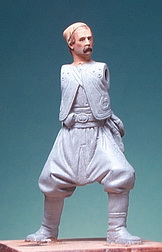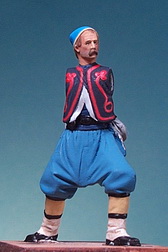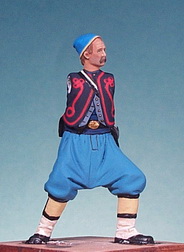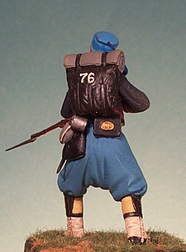HISTORICAL MINIATURES JOURNAL ISSUE NUMBER 8
PUBLISHED
BY GEORGE GRASSE
AMERICAN CIVIL WAR ZOUAVES
RESEARCH NOTES FOR MODELING
54mm SCALE AMERICAN CIVIL WAR ZOUAVES: PART
8
76th PENNSYLVANIA "KEYSTONE ZOUAVES" HISTORY
The Regiment was organized at
Harrisonburg on 18 October 1861 and left the state for Fort Monroe, Virginia,
the next day. Thus began its history and its assignments during its term
of service were:
|
From / To |
Brigade |
Division |
Corps |
Army |
|
Oct 1861 to Apr 1862 |
3rd Brigade |
Sherman's |
n/a |
Expedition
to South Carolina |
|
Apr 1862 to Jul 1862 |
2nd Brigade |
1st Division |
n/a |
Department
of the South |
|
Jul 1862 to Apr 1863 |
n/a |
n/a |
10th Army Corps |
Department
of the South |
|
Apr 1863 to Jun 1863 |
Guss' Brigade |
Seabrook Island |
10th Army Corps |
Department
of the South |
|
Jun 1863 to Jul 1863 |
2nd Brigade |
Folly Island |
10th Army Corps |
Department
of the South |
|
Jul
1863 to Jul 1863 |
2nd Brigade |
2nd Division |
10th Army Corps |
Department
of the South |
|
Jul
1863 to Aug 1863 |
1st Brigade |
Morris Island |
10th Army Corps |
Department
of the South |
|
Aug
1863 to Apr 1864 |
n/a |
Hilton Head |
10th Army Corps |
Department
of the South |
|
Apr
1864 to May 1864 |
2nd Brigade |
2nd Division |
10th Army Corps |
Department
of Virginia and N.C. |
|
May
1864 to Jun 1864 |
1st Brigade |
3rd Division |
18th Army Corps |
Department
of Virginia and N.C. |
|
Jun
1864 to Dec 1864 |
2nd Brigade |
2nd Division |
10th Army Corps |
Department
of Virginia and N.C. |
|
Dec
1864 to Jan 1865 |
2nd Brigade |
2nd Division |
24th Army Corps |
Department
of Virginia |
|
Jan
1865 to Mar 1865 |
2nd Brigade |
2nd Division |
Terry's Prov. Corps |
Department
of North Carolina |
|
Mar
1865 to Jul 1865 |
2nd Brigade |
2nd Division |
10th Army Corps |
Department
of North Carolina |
|
Jul 1865 Mustered Out |
- |
- |
- |
- |
The 76th Pennsylvania Infantry Regiment has one nickname:
the "Keystone Zouaves" and several engagements of fame and two of
significant importance: Fort Wagner in July of 1863 and Fort Fisher in January of 1865.
These major combats are part of a long, well-served history along the mid-Atlantic seaboard. The regiment spent the latter part of 1861 and early
part of 1862 on the South Carolina. Its first major engagement was the
Battle of Secessionville outside of Charleston, S.C., on 16 June 1862 after
which the unit moved to Hilton Head where it conducted various local operations
until April 1863. The 76th "Keystone Zouaves" then began operations that
centered around the assaults (11 and 18 July) and then siege until October 1863.
It returned to Hilton Head and remained there until April 1864.
Now began the period of operations against the
Richmond-Petersburg defenses. The regiment moved from Hilton Head to
Yorktown in April 1864. Between May 4 and 28, it was part of Butler's
operations on the south side of the James River. Bermuda Hundred was
captured 5 May 1864; Walthal Junction and Chester Station were taken 6-7 May;
action at Proctor's Creek and operations against Fort Darling 12-13 May; Battle
of Drewry's Bluff 14-16 May. Settled in at Bermuda Hundred 17-28 May.
All of this time, from July 1862 to April 1864, the 76th Pennsylvania was always
part of the 10th Army Corps.
In, May 1864, it was reassigned and became part of the
18th Army Corps under General William F. "Baldy" Smith, a major component of the
Army of the Potomac gathering at Cold Harbor under General U. S. Grant.
The Battle of Cold Harbor was fought 1 June 1864 and the 18th Army Corps
suffered the second highest number of casualties next to Hancock's 2nd Army
Corps. The results of that battle are well known. The 76th
Pennsylvania returned to the control of the 10th Army Corps after the battle and
entered into the siege operations against Petersburg lasting from 16 July to 6
December. During this period, the regiment participated in the following
actions during its involvement in the Petersburg siege: the Mine Explosion (in
reserve) 30 July; demonstration at Deep Bottom 13-20 August with actions at
Strawberry Plains and Deep Bottom; Battle of Chaffin's Farm, New Market Heights,
28-30 September; Battle of Fair Oaks 27-28 October; in the trenches around
Richmond until 6 December 1864.
The spectacular events involving the 76th Pennsylvania
"Keystone Zouaves" that led to war's end began with the expedition to Fort
Fisher, North Carolina coast, during the period 6-24 December 1864, as part of
the 24th Army Corps. A second expedition was mounted from 3-15 January
1865 resulting in a determined assault and the fort's capture on 15 January
1865. Reassigned back to the 10th Army Corps, the 76th was involved
in these closing actions: Fort Anderson 18-19 February; capture of Wilmington 22
February; advance on Goldsboro 6-24 March; advance on Raleigh 9-13 April; at
Bennett's House and the surrender of Johnston's army 26 April 1865.
The 76th Pennsylvania Regiment was mustered out of Federal service 18
July 1865 and during
its term of service from October 1861 to July 1865, it lost 9 officers and 161 enlisted men killed and mortally wounded and
2 officers and 192 enlisted men died of disease for a grand total of
364 war deaths.
THE UNIFORM
There are two photographs of privates of the 76th
Pennsylvania "Keystone Zouaves" in
Zouaves by Michael J. McAfee, pages 106-107. Both figures are
wearing fine examples of the uniform including the dark blue Zouave-style short
jacket with false vest, medium blue waistband piped in red, medium blue
trousers, white leggings, and tan-yellow leather "jambons" worn around the top
of the leggings. The jacket is adorned with deep red piping around the edges,
trefoils with brass buttons, and cuff chevrons worn "points up". The
fez was medium blue with yellow piping around the
base and a dark blue tassel. This uniform was probably worn during the
unit's service along the Atlantic Coast.
Trousers were without adornment and of a
fit the appears to be closer to the true, baggy "zouave-style" than the slimmer,
tailored cut or "chasseur-style". The legs of the pants were tucked into white leggings
which were wrapped at the top by a yellow-tan leather "jambon" which
often reflects a dark or black shade in period photographs. Legging buttons were bone or metal
wrapped in white cloth.
The unit carried the Springfield rifled-musket, with cap
box worn at the right front, a cartridge box worn on the right rear hip, and a
bayonet in its scabbard worn on the left, dangling from the waist belt.
Other equipment included black waterproof haversack,
a canteen with cloth cover of varied shades, and a tin cup. The knapsack was standard Federal issue and was
probably marked "76", or "76 PA", or "76 PA KZ" on the back in white.
A rolled blanket also of varied shades of brown-gray was secured to the top of
the knapsack.
Making THE
76th PENNSYLVANIA "KEYSTONE ZOUAVE"
One figure will be constructed using the one of the standard
poses from Shenandoah's 5th New York Zouave kits, in this case SHZ010 standing
crouched firing. The figure will have the left arm replaced by another
which is slightly extended so that I can create the pose of raising the rifle to
take aim. I will also add a tin cup and the knapsack as shown in Figure 1
which shows the kit before any work is done.
| Figure 1
 |
The head I used was from my Union
Zouave fez-headed spare parts tray from the Shenandoah Zouave head set (not the
head shown in Figure 1).
This figure will have knapsack straps added for the knapsack,
not a kit-supplied item. A tin cup is another added feature. You will
see these items later in the construction/painting phase. First step is cleaning
up the figure's seam lines on all parts and polishing them with a
Dremel tool using a #428 wire brush. A false vest will be
added later on in the process.
As far as assembly goes, I only super glued the head to the body. Next step is priming. This is done by laying out
the parts on wax paper and spraying with an appropriate primer for
metal or resin figures. In general, these are fine spray
primers. You don't need heavy coverage or you could obliterate
fine details or leave an undesirable grainy surface. Another alternative is to prime with the
brush using a product such as Model Master MA4622 brush-on white
acrylic primer. When dry, I mounted
the figure on a "work" base with just a couple of small drops of
super glue.
|
| Figure 2 shows the primed figure on its
working base with the face painted according to these steps: 1) off-white for eyes; 2) outline the eyes in a dark brown
color such as Vallejo VC0872 Chocolate brown; 3) add the eyes either
looking straight ahead of off at an angle (note that the top of the
eyeball is normally not visible except when someone is excited); 4)
add the main or middle flesh color of your palette and include all
of the hair and facial hair (if present); 5) wash the lower part of
the face from the ears down with a thinned, watered-down mix of middle flesh and
dark flesh; 6) wash the temples and inside of the ears with a
thinned, watered-down mix
of middle flesh and a tiny drop of scarlet; 7) wash the beard area with
a mix of medium flesh and a little medium gray; 8) touch up the high
or projecting areas of the face (bridge of the nose, nostrils,
outside edges of the ears) with a mix 50-50 of medium and light
flesh; 9) paint the lower lip with a mix of medium flesh and touch
each of scarlet and dark brown, a little darker than the temple shade; 10) paint a
thin line between the upper and lower lips; 11) wash the hair in
whatever thinned down version of color you want: medium brown, dark
brown, red brown; keep this mixture as a wash and note how the
flesh-colored hair automatically reveals the highlight color. |
Figure 2

|
Figure 3
Figure 4
 |
The basic elements of the uniform are started as
shown in Figure 3. The fez and trousers are painted a light
shade of medium blue. These will be finished in a thinned-down
wash of a true medium blue. The "jambons" have a base coat of
yellow ochre and the leggings are true white. Both will be
washed with darker shades of the same colors. I painted the
shirt a dark blue. The false vest will be added in the next
step.
Figure 4 shows the addition of the false vest and painted
details of the jacket and leg-wear. Basic equipment that is cast onto the
figure (cartridge box, cap, box, haversack, and canteen) will be painted in the
next step.
|

|
Figure 5
|
 |
Figure 5 shows all details of the uniform
painted. The trefoil "loop holes" are painted the color of the
jacket which shows through the lace. In some regiments,
the "loop holes" were filled in with lace or had a button sewn in
place. Recall that the false vest,
here made from thin
lead foil to which are added small droplets of white glue for the
buttons, was intended to allow the soldier to button up his jacket
but give the appearance of being open as was the French Zouave
style.
At this point I'd like to point out that this
figure represents a private in pristine, parade dress, fresh-issue
uniform. It doesn't take much imagination to picture this
figure after having been in the field for 6 months. The
jambieres would have been "lost", he may or may not have retained
the leggings, and he may have worn out the baggy trousers and
adopted a pair of regulation issue replacements. |
|
Figure 6
 |
Figures 6 and 7 show the
completed figure. Knapsack belts to support the knapsack and
rolled blanket were added before the arms were fitted and glued in
place. This particular pose required several trial fittings
which required slight bending of the upper arms. Once glued in
place, gaps were filled with Monogram's Red Putty and sanded.
The number "76" in white on the knapsack is my interpretation.
When infantry regiments went into line from route march, knapsacks
and non-essential items were dropped in an area. Several men
were detailed to guard them while the regiment moved off.
Identifying numbers on these knapsacks were quite common but artist
and photographers of the period did not create an historical record.
Relics are too few to give an overall sample of every regiment.
The inscription might also be interpreted as "76 Pa" (Pa =
Pennsylvania) or "76 PV" (PV = Pennsylvania Volunteers) or "76 KZ"
(KZ = Keystone Zouaves).
|
Figure 7
 |
--------------------------------------------------------------------------------------------------------------------------------
REFERENCES
A Compendium of the War of the
Rebellion, Frederick H. Dyer, Volume III, Thomas Yoseloff publisher, New
York, 1959 (see page 1599).
Don Troiani's Civil War, Don
Troiani, text by Brian Pohanka, Stackpole Books, Mechanicsburg, PA, 1995 (see
page 86).
Zouaves: The First and the Bravest,
Michael J. McAfee, Thomas
Publications, Gettysburg, PA 1991
(see notes on page 91and photos on pp.106-107).
American Civil War Zouaves,
Osprey Elite #62, by Robin Smith, illustrated by Bill
Younghusband, Osprey Publishing, Oxford, UK, 1996 (see pages 29-30 and plate
H #3).
Echoes of Glory: Arms and Equipment
of The Union, by the Editors of Time-Life Books,
Alexandria, Virginia, 1991 (see page 142).
GO TO?
© Copyright by George Grasse






